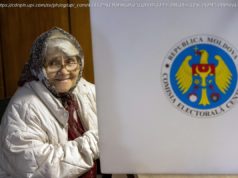First Lady Melania Trump chose not to wear a head scarf when she and President Donald Trump arrived in Riyadh, Saudi Arabia on Saturday. Ivanka also chose not to wear a head covering.
Melania Trump was dressed elegantly in all-black when she and her husband landed in Saudi Arabia Saturday morning, but the first lady chose not to cover her head.
When she emerged from Air Force One at Riyadh’s King Khalid International Airport, the Melania’s attire was conservative.
The 47-year-old former model wore black patent stilettos and what is believed to be a $1,495 black Stella McCartney jumpsuit, cinched at the waist with a wide gold belt.
But she was missing a head scarf, which is common for women in Saudi Arabia, a religious country that has some of the world’s harshest restrictions on women.
The President’s daughter and advisor Ivanka Trump also opted-out of wearing a head scarf for the state visit.
She wore a $1,490 long-sleeved printed Cédric Charlier maxi dress that showed her ankles and her tan pumps as she held hands with her husband Jared Kushner.
Though women are required to dress conservatively and most wear head scarves, many visiting Western women choose not to wear one.
Melania’s predecessor Michelle Obama did not cover her head when she accompanied then-President Barack Obama on a condolence visit in January 2015 after the death of King Abdullah.
Donald Trump tweeted his disapproval at the time, saying: ‘Many people are saying it was wonderful that Mrs. Obama refused to wear a scarf in Saudi Arabia, but they were insulted. We have enuf enemies.’
The President also gave his trademark thumbs up to the press as he rode the escalator from the tarmac to the royal terminal at the airport in Riyadh.
In much of the Arab world, the gesture is considered a vulgar sexual insult, even though many in Saudi Arabia have disputed that.
Under the kingdom’s strict dress code for women, Saudi women and most female visitors are required to wear a loose, black robe, known as an abaya, in public.
It is generally frowned upon to wear pants and women are expected to cover their hair and face with a veil known as the niqab.
But covering one’s head is not required for foreigners, and some Western women choose to forego the headscarf while in Saudi Arabia.
Earlier this year, British Prime Minister Theresa May and German Chancellor Angela Merkel also shunned head coverings, showing how common it is for high-level female visitors to skip wearing a headscarf or an abaya.
And during her time as first lady, Laura Bush generally went without covering her head, though she once briefly donned a head scarf she received as a gift.
As Obama’s secretary of state, Hillary Clinton also did not cover her head on visits to Saudi Arabia.
Saudi Arabia adheres to an ultraconservative interpretation of Islamic Shariah law where unrelated men and women are segregated in most public places. Women are banned from driving, although rights advocates have campaigned to lift that ban.
Guardianship laws also require a male relative’s consent before a woman can obtain a passport, travel or marry. Often that relative is a father or husband, but in the absence of both can be the woman’s own son.
The country is at a potentially unprecedented crossroads, with its future identity at stake as economic and political interests have brought to the limelight longstanding gender norms.
Local media on Thursday quoted Saudi Arabia’s foreign minister as saying authorities did not demand anyone adhere to any specific clothing regulations.
The US State Department’s website says women who choose not to conform to wearing ‘a full-length black covering known as an abaya, and cover their heads… face a risk of confrontation by Mutawwa and possible detention/arrest’ in Saudi Arabia.
The Mutawwa, which literally translates to ‘volunteers’ from Arabic, are Saudi Arabia’s Commission of the Promotion of Virtue and the Prevention of Vice, known as the ‘morality police’.
Following accusations the Mutawwa were abusing their power, Saudi Arabia last year announced the religious police could no longer arrest suspects or request identification.






